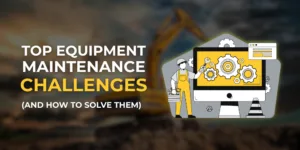For businesses looking to differentiate themselves in today’s competitive landscape, understanding the basics of field service is no longer optional—it’s crucial. Field service operations are at the heart of customer experience, often dictating the customer’s lasting impression of your brand. Each step is pivotal in ensuring customer satisfaction and loyalty from the initial service call to the final handshake.
In this post, we’ll be exploring the critical role of a field service technician: a key player who juggles technical prowess with customer service skills through a comprehensive field service training program, technicians are equipped with the necessary tools, knowledge, and confidence to execute their jobs effectively, fostering positive interactions that resonate with customers long after service completion. Join us to explore how robust training can impact your service quality and business success.
How AR and WOMS Supercharge Field Service Training
Augmented reality (AR) is radically changing the nature of training within the field service industry. Service technicians can now rehearse basic skills and repairs in simulated hazardous conditions without being endangered to be better prepared for live operation. Despite these technological advances, current training platforms need more data to mirror a wider range of real-world scenarios, prioritize training workflow updates, and holistically diagnose the technician’s performance. Integrating work order management software (WOMS) with AR training platforms can enhance the training experience, and a deeper understanding of performance can be assessed.
Live Training
Most traditional training programs are sandboxed environments that lead trainees through scenarios with predefined problems and solutions. Unfortunately, this paradigm belies the complexity often required during actual maintenance. For instance, in diagnosing elaborate equipment like the engine of a backhoe loader, there are many factors to consider before you can pinpoint the core issue. The type of operation, weather conditions, and usage history can affect the troubleshooting steps that should be taken and the field service that might be required.
A WOMS can collect this information by connecting to sensors and other IoT devices. From the sensor readings, the WOMS can identify anomalies from harsh usage, poor weather conditions, and extended operation and display relevant information on the AR interface. The WOMS can often scan a bar/QR code asset tag, determine the specific unit configuration, and tailor the guided instructions accordingly. It can provide a dynamic on-the-job training experience that minimizes the risk from unknown variables in the field and from junior technicians who may have little experience outside of contained training modules.
Training Priority and Updates
Technicians often face new software and hardware updates for their diagnosing equipment. As a result, they need to constantly stay up to speed on the latest iterations of the equipment. The steps required to replace a component one year could be obsolete the following year. Updates to training modules may be delayed, which could impact the service team’s customer experience. Besides, internal process changes can also hold up critical and time-sensitive training required for technicians to be current and effective.
A WOMS can help prioritize AR training modules that require prompt updates and keep technicians informed about when to renew their training. There is an enormous database of information available to technicians in the WOMS. To make sense of this data, applying analysis tools that use AI or machine learning may allow for the detection of historical utilization trends along with common failure points. Service issues that are low probability but high consequence, time-sensitive, or critical for the system’s integrity can be prioritized for training updates and help the company define team training schedules.
Moreover, if the asset has an above-normal utilization, regular service will be required sooner and more frequently. The WOMS could trigger updates to the training modules for the asset and inform the technician to review the updates. Simultaneously, the WOMS can notify the technician to renew their certifications or even suspend their return to the field until the new training is complete. It ensures technicians are up to speed on the most relevant training and helps the service company develop a comprehensive training curriculum.
Deeper Performance Analysis
Current field service training programs provide surface insight into the technician’s efficacy during isolated training sessions. However, these sessions mainly highlight basic and repetitive tasks. Performance data is limited to demonstration cases, which can skew expectations without gauging the skills applied during actual work.
Integrating the AR training platform with a WOMS allows the possibility of a bi-directional data engine that processes performance data in controlled training sessions and live situations. The AR platform can guide and improve training intelligence, and the data gathered during actual fieldwork could be used to optimize the learning process. For example, the WOMS can aggregate time spent on each step of the work order in the field and correlate this information with training results. It allows a better discussion with management about time spent, what can be more effective in optimizing training exercises, and whether new scenarios must be arranged in the demo environment to mimic reality further.
Pro Tip: Integrate your AR training platform with a WOMS to prioritize updates, tailor training modules, and analyze technician performance effectively, ensuring continuous improvement in field service training.
Refining Customer Communication and Service Mastery in Field Service Training
The art of customer communication and service skills is at the core of exceptional field service. Mastering these essential facets elevates your clients’ experience and strengthens your services’ reputation and trustworthiness. Below, we delve into the vital components of customer relations that every field service professional should cultivate.
The Key to Effective Customer Relations
Effective customer relations hinge on understanding and empathy. Being able to anticipate customer needs and respond to them with professionalism ensures a level of service that often surpasses expectations. Strong customer relations are the bedrock of enduring business success and can set you apart in a competitive field service landscape.
Communication Techniques for Successful Service Calls
- Using layman’s terms to explain complex technical issues
- Maintaining a positive and helpful tone, regardless of the service challenge at hand
- Being mindful of body language and non-verbal cues that contribute to the overall communication
Building Trust and Ensuring Customer Loyalty
Trust is the currency of all lasting relationships with your customers. It is earned through consistent, reliable service and transparent communication. Ensuring customer loyalty involves:
- Providing honest service estimates and avoiding unnecessary upsells
- Following up post-service to confirm satisfaction
- Fostering an open channel for feedback and being responsive to it
By incorporating these elements into your field service training, you will be well on your way to mastering the art of customer communication and enhancing service skills that promote a thriving service environment.
Mastering Technical Skills and Product Knowledge
A solid foundation in equipment expertise and technical proficiency lies at the core of exceptional field service. Technicians must be adept in their trade mechanics and have an intimate understanding of the products they service. This dual commitment to technical skills and product knowledge is non-negotiable for those seeking to excel in field service training.
The Bedrock of Field Service: Equipment and Technical Know-How
A deep-rooted understanding of the equipment differentiates a competent technician from an outstanding one. Technical know-how enables professionals to accurately diagnose issues, perform efficient repairs, and anticipate potential malfunctions before they escalate into larger problems. Investing time in hands-on training and technical workshops is crucial to mastering this aspect of field service.
Staying Ahead: Continuous Learning in Evolving Technologies
The technology landscape is ever-changing, and field service specialists must evolve alongside these advancements. Engaging in continuous learning keeps technicians at the forefront of the industry, allowing them to offer the most current solutions and maintain a competitive edge. This ongoing education may include formal training sessions, online courses, or self-study of emerging technologies.
Pro Tip: Prioritize hands-on training and continuous learning opportunities to ensure technicians stay adept in equipment expertise and up-to-date with evolving technologies, enhancing their ability to deliver exceptional field service.
Prioritizing Safety Procedures and Compliance
Ensuring the safety of both technicians and customers is paramount in field service training. By integrating robust safety procedures and ensuring compliance with industry standards, organizations can foster a culture of safety that protects all parties involved.
Ensuring the Safety of Technicians and Customers
The well-being of field service technicians is a critical component of any safety program. Training must encompass the correct handling of equipment, proper ergonomic practices, and the use of personal protective equipment (PPE). Moreover, safeguarding customers during service calls is equally important. Technicians should be trained in identifying potential hazards and mitigating risks while on the customer’s premises.
Adhering to Industry Standards and Regulations
Compliance with regulatory requirements is a legal obligation and a cornerstone of professional credibility. Field service training should cover key regulations that impact field service operations, including Occupational Safety and Health Administration (OSHA) guidelines, environmental protection laws, and specific industry codes of practice.
Implementing Best Practices for Risk Management
- Risk Assessment: Training should include thorough risk assessments for different field scenarios.
- Emergency Procedures: Technicians must be well-versed in emergency response protocols in case of accidents or hazards.
- Continuous Improvement: Encouraging a feedback loop where technicians can report potential risks and suggest improvements to safety measures.
Adopting these safety-focused approaches in field service training ensures compliance, builds customer trust, creates a secure work environment, and upholds the service provider’s reputation.
Harnessing Tools and Technology for Field Service
As the field service industry evolves, so does the importance of integrating advanced tools and technology into the service toolbox. Modern technicians must be proficient with various equipment and software to deliver efficient and effective services. A robust understanding of these tools is essential for staying competitive in today’s fast-paced service environment.
The Modern Technician’s Toolkit: From Basics to Advanced Equipment
Field service professionals must have a well-rounded toolkit beyond basic hand tools. It includes using sophisticated diagnostic equipment, IoT devices that enable remote monitoring, and advanced tools that support precision work. Equipping technicians with the latest tools can dramatically increase their ability to diagnose and resolve issues quickly.
Embracing Mobile and Cloud-Based Field Service Solutions
The adoption of mobile and cloud-based solutions is reshaping the field service landscape. These technologies facilitate better communication and collaboration among service teams, provide real-time access to customer data and service histories, and provide more responsive service delivery. Utilizing mobile apps and cloud platforms, technicians can update job statuses, access technical manuals, and manage service schedules from anywhere, thus driving greater efficiency and customer satisfaction.
The Impact of Emerging Technologies on Field Service
Emerging technologies such as Augmented Reality (AR), Artificial Intelligence (AI), and Machine Learning are transforming field service training. AR can be used for remote assistance and interactive training, providing technicians with visual guidance during complex repairs. AI and Machine Learning, on the other hand, enhance predictive maintenance capabilities and personalize customer service experiences. These technologies help create smarter service strategies and are crucial in proactive problem-solving.
Pro Tip: Master various tools and tech, from diagnostics to cloud solutions and emerging AR, AI, and machine learning, for a competitive edge in field service.
Optimizing Time Management and Scheduling in Field Service Training
Effective time management and strategic scheduling are pivotal aspects of field service training that contribute to heightened productivity and improved customer satisfaction. Mastering these components ensures that field service technicians can provide quality service while managing their workload efficiently.
Planning and Prioritizing: The Key to Maximizing Productivity
Field service technicians can tackle their responsibilities methodically by adequately planning their day and prioritizing tasks. It ensures a structured approach to the workday and minimizes time wasted deciding which job to address next. Proper planning involves:
- Assessing the urgency and importance of each task.
- Allocating sufficient time for high-priority tasks.
- Establishing a sequence of actions that minimizes downtime between jobs.
Scheduling Strategies for Field Service Technicians
Scheduling is more than just assigning jobs; it’s about creating a workflow that allows for flexibility in the face of unforeseen challenges while ensuring all commitments are met. Effective scheduling should consider the following:
- The proximity of job locations to minimize travel time.
- Allocating buffer periods to manage delays and unexpected job complexities.
- Adjusting workloads to prevent technician burnout.
Leveraging Software for Efficient Route and Job Allocation
In today’s digital era, field service technicians can greatly benefit from software designed to optimize routing and job allocation. Leveraging these technologies allows for:
- Automated scheduling based on technician availability, location, and skill set.
- Dynamic routing that adjusts in real-time to traffic conditions and job updates.
- Insights into performance metrics to continually refine scheduling processes.
Pro Tip: Maximize productivity by planning tasks, prioritizing based on urgency, and leveraging software for efficient scheduling and route optimization in field service training.
Effective Inventory Management and Parts Handling
For professionals engaged in field service training, mastering the nuances of inventory management is essential. Effective oversight and handling of parts promotes efficiency and ensures service excellence. Let’s explore the critical components that enable smoother operations and customer satisfaction.
Ensuring the Right Parts Are at the Right Place, at the Right Time
The core of successful field service operations lies in the logistical precision of having the necessary parts available where and when they are needed. This precision impacts every service aspect, from customer wait times to job completion rates. Field service professionals can enhance service reliability and reputation by striving for this gold standard in parts availability.
Inventory Tracking Methods and Stock Optimization
Accurate inventory management hinges upon robust tracking methods. Modern inventory systems allow service providers to maintain optimal stock levels, reduce waste, and avoid costly downtime. A well-implemented tracking system streamlines the workflow and provides valuable data for future planning and stock optimization.
Best Practices for Handling and Transportation of Parts
- Inventory Assessment: Regularly review your inventory levels to prevent overstocking or understocking of parts.
- Quality Control: Implement procedures to inspect parts upon receipt and before dispatch to guarantee they meet quality standards.
- Efficient Storage: Organize inventory to facilitate easy access, minimize handling time, and prevent damage.
- Transportation Logistics: Select appropriate transport methods and plan routes effectively to expedite delivery times and reduce costs.
Focusing on these essential elements can help field service technicians achieve greater productivity and ensure a seamless service flow. It, in turn, solidifies their role as trusted and dependable experts in the field service industry.
Enhancing Service Documentation and Reporting
One vital skill in field service training is service professionals’ ability to maintain impeccable service documentation and reporting practices. As industries evolve, so does the need for accurate records to ensure consistency, reliability, and accountability in field service operations.
The Importance of Accurate Service Records
Reliable service documentation is the cornerstone of successful field service management. Accurate records help track work history and verify services rendered and are crucial for audit purposes, warranty claims, and future service planning. A well-documented service can considerably enhance customer trust and ensure compliance with industry standards.
Streamlining Documentation Through Digital Tools
With technological advancement, digital tools have become indispensable in streamlining documentation processes. Field service training includes familiarizing technicians with mobile applications and software that facilitate real-time data entry, instant access to service histories, and the ability to update job statuses on the go, thus reducing paperwork and errors associated with manual entry.
Reporting Templates and Tools for Field Service Engineers
To further strengthen the reporting aspect of service management, equipping field service engineers with standardized reporting templates and tools is essential. These resources enable quick and consistent report generation, covering all critical service aspects from issue diagnosis to actions taken, parts used, and customer feedback. By utilizing structured reports, service professionals can provide thorough and standardized documentation for every job.
- Effective use of customizable templates for varying job types
- Integration of reporting tools with inventory and CRM systems
- Accessibility of detailed analytics for performance assessment and improvement
In conclusion, field service training must emphasize the crucial role of proficient documentation and reporting. By harnessing digital solutions and standardized practices, field service providers can achieve optimal efficiency and enhance customer satisfaction.
Key Takeaways
- Transitioning to electronic forms and checklists minimizes paper waste and storage demands, streamlines workflows, reduces errors and ensures up-to-date documentation.
- Leveraging augmented reality (AR) combined with work order management software (WOMS) provides dynamic, real-time training and updates, enhancing technicians’ preparedness and reducing risks associated with real-world scenarios.
- A WOMS can prioritize and prompt updates to training modules, ensuring technicians stay current with the latest software, hardware, and internal process changes, thus maintaining high service standards.
- Mastering effective communication techniques and building trust through honesty and professionalism are crucial for fostering strong customer relations and ensuring long-term customer loyalty.
Final Thoughts
It is more important than ever to have training programs that can keep pace with the rapidly changing environment, products, and training technology. Integrating the AR training platform with a WOMS will provide a higher assurance that relevant data is being captured and used to tailor more realistic training to technicians. There are still some questions about the implementation of this technology. Will technological developments in mobile devices and headgear-based lenses alter how we think about AR and WOMS integration? How do we organize and process information that is clear and simple enough for technicians to make choices and execute? Will there be standards across AR devices to help developers integrate with WOMS and vice versa? Time will tell. For now, combining WOMS and AR will constitute a potent training application that will empower the next wave of field service technicians.



 June 27, 2025
June 27, 2025 3 minutes read
3 minutes read

